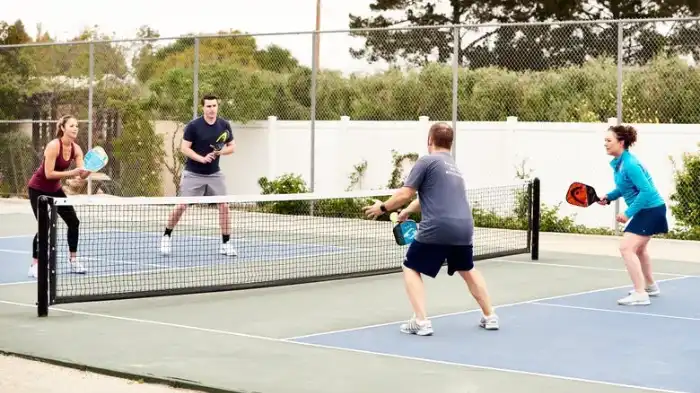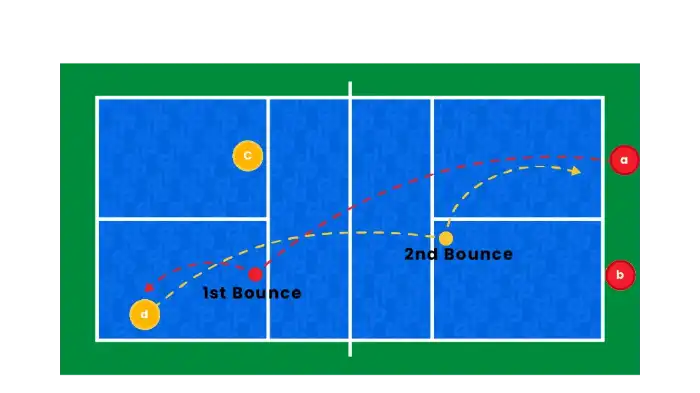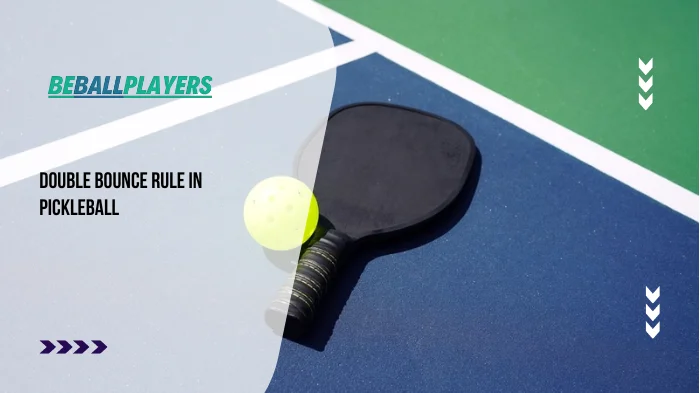Pickleball is a popular racquet sport that combines elements of tennis, badminton, and ping pong. It is played with a solid paddle and a perforated plastic ball on a court divided by a net. One of the key rules in pickleball is the double bounce rule, which ensures fair play and promotes exciting rallies. In this blog, we will delve into the Double Bounce Rule in Pickleball, its significance, and how it affects the gameplay.
Introduction to the Double Bounce Rule
The double bounce rule in pickleball states that both teams must let the ball bounce once on each side before volleys, which are shots hit in the air without letting the ball bounce. This rule applies only at the beginning of each point, with the first team to correctly execute the double bounce winning the right to volley the ball.

If a team violates the Double Bounce Rule in Pickleball, they lose the serve or the opportunity to score a point. This rule ensures that each team has an equal chance to return the ball and encourages longer rallies.
Why is the Double Bounce Rule in Pickleball Important?
The double bounce rule plays a crucial role in maintaining fairness and balance in pickleball. It prevents an intimidating volley dominance and creates a level playing field for both teams, regardless of their skill level. This rule caters to players of all ages and abilities, making the sport accessible and enjoyable for everyone. By forcing the ball to bounce on each side before volleys, it allows more time for players to react and return shots, promoting longer and more exciting rallies.
Furthermore, the double bounce rule adds an extra layer of strategy to the game. Players must strategically place their shots in a way that makes it challenging for their opponents to return the ball after the double bounce. It encourages tactical thinking, shot placement, and anticipation, enhancing the mental aspect of pickleball.
Implementation and Exceptions
The double bounce rule is applied differently depending on whether players are serving or receiving. Let’s examine the rule’s implementation for both scenarios:
Serving Team
When serving, the team must hit the ball diagonally over the net, ensuring it lands in the opponent’s service court. The receiving team lets the ball bounce once before returning it. After the receiving team hits the ball back, the serving team must also let it bounce once before they can enter into a volley. If either team fails to execute the double bounce correctly, they lose the serve and the opposing team gains the opportunity to score.
Receiving Team
When the receiving team successfully returns the serve, they must let the ball bounce once before they can enter into a volley rally. Similarly, if either team fails to comply with the double bounce rule, they lose the opportunity to score, and the opposing team regains the serve.
It is important to note that once the ball has been properly double bounced on both sides, teams are then allowed to volley the ball, hitting it out of the air without letting it bounce. The double bounce rule only applies at the beginning of each point.
Strategies for Excelling with the Double Bounce Rule
Mastering the Double Bounce Rule in Pickleball is essential for players looking to excel in pickleball. Here are a few strategies to help you make the most of this rule:

Shot Placement
By placing your shots strategically, you can make it challenging for your opponents to return the ball after the double bounce. Aim for areas in the court where your opponents are less likely to have a clear shot, increasing your chances of gaining an advantage in the rally.
Anticipation
Anticipating your opponent’s shots can give you the split-second advantage needed to position yourself correctly and prepare for the ball. Reading your opponent’s body language, shot patterns, and court positioning can greatly enhance your ability to anticipate where the ball will go after the double bounce.
Quick Reflexes
Improving your reflexes can make a significant difference in your ability to return shots after the double bounce. Practice drills that focus on reaction time and quick movements, as these skills will help you handle fast-paced rallies with precision.
Conclusion
The Double Bounce Rule in Pickleball is an essential element that promotes fair play, encourages longer rallies, and adds a strategic dimension to the game. By ensuring that the ball bounces once on each side before volleys, the rule creates an equal opportunity for both teams to return shots.
As with any rule, mastering the Double Bounce Rule in Pickleball requires practice, anticipation, and refined shot placement. So go ahead, embrace the double bounce rule, and enjoy the exciting and challenging gameplay it brings to the wonderful sport of pickleball!
Frequently Asked Questions
The double bounce rule in pickleball refers to the requirement that each team must let the ball bounce once on their own side after the serve, and also once on the opponent’s side before they can volley the ball in the air.
The double bounce rule ensures a fair and balanced gameplay by giving both teams an opportunity to return the serve from a position closer to their respective baseline. This rule benefits players of all skill levels, making the game more inclusive and enjoyable for everyone.
Yes, there are a few exceptions to the double bounce rule. The rule doesn’t apply during the serve – the serving team can volley the ball without letting it bounce. Furthermore, if the ball bounces twice before the receiving team hits it back, the serving team wins the point.
The double bounce rule encourages players to strategically place their shots in order to force their opponents to hit a difficult return after the second bounce. It also promotes volleys and rallies, as players must rely on their reflexes and positioning to return the ball effectively.
If a player fails to let the ball bounce before volleying during the first two shots of a point, the opposing team earns a point. It’s important for players to stay mindful of this rule to maintain fairness and sportsmanship in the game of pickleball.

